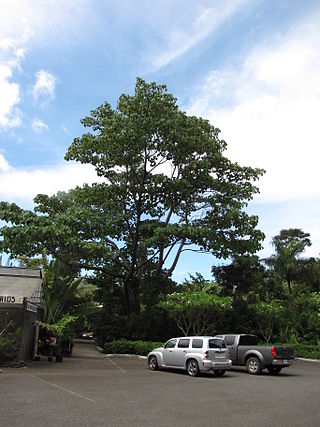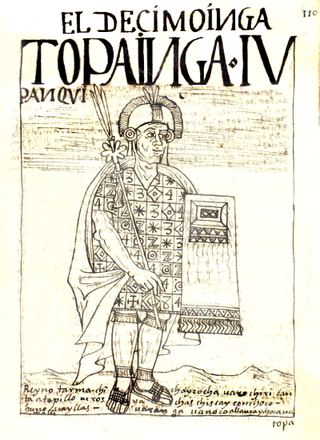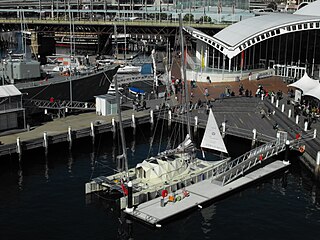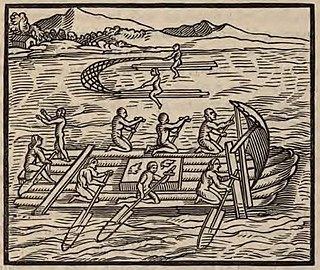
Thor Heyerdahl KStJ was a Norwegian adventurer and ethnographer with a background in biology with specialization in zoology, botany and geography.

Ochroma pyramidale, commonly known as the balsa tree, is a large, fast-growing tree native to the Americas. It is the sole member of the genus Ochroma. The tree is famous for its wide usage in woodworking, due to its softness and its high strength compared to its low density. The name balsa is the Spanish word for "raft."

The Kon-Tiki expedition was a 1947 journey by raft across the Pacific Ocean from South America to the Polynesian islands, led by Norwegian explorer and writer Thor Heyerdahl. The raft was named Kon-Tiki after the Inca god Viracocha, for whom "Kon-Tiki" was said to be an old name. Heyerdal's book on the expedition was entitled The Kon-Tiki Expedition: By Raft Across the South Seas. A 1950 documentary film won the Academy Award for Best Documentary Feature. A 2012 dramatized feature film was nominated for the Academy Award for Best Foreign Language Film.

Topa Inca Yupanqui or Túpac Inca Yupanqui, also Topa Inga Yupangui, translated as "noble Inca accountant," was the tenth Sapa Inca (1471–93) of the Inca Empire, fifth of the Hanan dynasty. His father was Pachacuti, and his son was Huayna Capac. Topa Inca belonged to the Qhapaq panaca. His qoya was his older sister, Mama Ocllo.

Puka-Puka is a small inhabited coral atoll in the north-eastern Tuamotu Archipelago, sometimes included as a member of the Disappointment Islands. This atoll is quite isolated, the nearest land being Fakahina, 182 km to the southwest.

Knut Magne Haugland, DSO, MM, was a resistance fighter and noted explorer from Norway, who accompanied Thor Heyerdahl on his famous 1947 Kon-Tiki expedition.
In Pre-Incan mythology, Kón (Con) was the god of rain and wind that came from the North. He is thought to be a deity to the Paracas Civilization, who was later adopted into Nazca and Incan mythology through different names. He was a son of Inti and Mama Killa.

The Tangaroa Expedition of 2006 closely resembled the Kon-Tiki expedition sailing a balsa raft from Peru to Polynesia. Tangaroa outperformed Kon-Tiki by having an improved sail rig and by actively using guaras (centerboards). As such, the expedition represents a scientific continuation of Thor Heyerdahl's experiments in recreated maritime technology.
The Kantuta Expeditions were two separate expeditions on balsa rafts led by the Czech explorer and adventurer Eduard Ingris.

William Willis was an American sailor and writer who is famous due to his solo rafting expeditions across oceans.

The Kon-Tiki Museum is a museum in the Bygdøy peninsula in Oslo, Norway. It houses vessels and maps from the Kon-Tiki expedition, as well as a library with about 8,000 books. It was opened in a provisional building in 1949. In 1957, the current building—designed by architects F. S. Platou and Otto Torgersen—was opened. In 1978, an extension of the museum designed by Torgersen was opened.

The Plastiki is a 60-foot (18 m) catamaran made out of 12,500 reclaimed plastic bottles and other recycled PET plastic and waste products. Michael Pawlyn of Exploration Architecture worked on the concept design with David de Rothschild and helped to shape some of the key ideas. The craft was built using cradle to cradle design philosophies and features many renewable energy systems, including solar panels, wind and trailing propeller turbines, and bicycle generators. The frame was designed by Australian naval architect Andrew Dovell. The boat's name is a play on the 1947 Kon-Tiki raft used to sail across the Pacific by Norwegian explorer Thor Heyerdahl, and its voyage roughly followed the same route.
Éric de Bisschop was a French seafarer, famous for his travel from Honolulu to France aboard the Polynesian sailboat Kaimiloa.

Kon-Tiki is a 2012 historical drama film directed by Joachim Rønning and Espen Sandberg about the 1947 Kon-Tiki expedition. The film was mainly shot on the island of Malta. The role of Thor Heyerdahl is played by Pål Sverre Hagen. The film is an international co-production between Norway, Denmark, Germany, Sweden and the United Kingdom.
L’Égaré II was the name of a raft used by a French crew in 1956 to cross the Atlantic Ocean. The expedition, led by Henri Beaudout, departed from Halifax, Nova Scotia, arriving 88 days later at Falmouth, England.

Erik Bryn Hesselberg was a Norwegian sailor, author, photographer, painter and sculptor. He is most known as a crewmember of the Kon-Tiki raft expedition from South America to French Polynesia in 1947.

Torgeir Sæverud Higraff is an explorer, teacher and author with special interest in prehistoric transoceanic contact. Like Thor Heyerdahl, Higraff combines history, anthropology and traditional knowledge with expeditions. In 2002, the year Heyerdahl died, Higraff decided to recreate the Kon-Tiki expedition, and in 2006 the Tangaroa Expedition sailed from Peru to Raiatea in eastern Polynesia. Tangaroa outperformed Kon-Tiki by using an improved sail rig and active use of the guara centerboards.
The Viracocha expedition were expeditions led by professional explorer Phil Buck in 2000 and 2003 when he led multiple international teams across the Pacific Ocean, traveling from South America to Easter Island on two distinct ancient-style reed rafts with the aim of proving that South American mariners could have reached Easter Island. Both vessels were constructed using four Andean materials: totora reeds, natural fiber rope, cotton sails, and wood.

Between 1966 and 1973, Spanish explorer Vital Alsar led three expeditions to cross the Pacific Ocean by raft – La Pacífica in 1966, La Balsa in 1970 and Las Balsas in 1973. Travelling from Ecuador, South America, to Australia, the first expedition failed, but the second and third succeeded, both setting the record for the longest known raft voyages in history – 8,600 miles (13,800 km) and 9,000 miles (14,000 km) respectively.

Pre-Columbian rafts plied the Pacific Coast of South America for trade from about 100 BCE, and possibly much earlier. The 16th-century descriptions by the Spanish of the rafts used by Native Americans along the seacoasts of Peru and Ecuador has incited speculation about the seamanship of the Indians, the seaworthiness of their rafts, and the possibility that they undertook long ocean-going voyages. None of the prehistoric rafts have survived and the exact characteristics of their construction and the geographical extent of their voyages are uncertain.
















